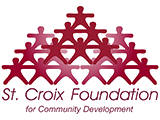The U.S. Virgin Islands faces many challenges. The one common thread of agreement is that the future of our islands depends on our children. Their education, physical and emotional health, and the opportunities provided to them are essential to creating a brighter future for all who reside here. In editorials, legislative hearings, conversations on the stoops around the islands, and on talk radio, most are in agreement that we are failing to educate our children in a way that will ensure their success, and that we need to take action to overcome that failure. The complication continues to center on how to accomplish this reform.
In this spot, for the next twenty weeks up until Election Day, the St. Croix Foundation will be offering a variety of articles on issues that our community needs to consider to achieve system-wide educational reform. They are not meant as prescriptive but as conversation starters for honest dialogue within the community. Recognizing that it is much easier to discuss how to correct faults in the physical plants of our schools than it is to discuss how to correct faults in the system itself, we want to challenge everyone in our community to consider the following: What does our system look like? What does our community value when it comes to education? What does the global economy demand of our children? And, what is our vision for our children and our Territory? We believe that delving deep into these questions needs to be a high priority in our communities and for our elected officials and policy makers. It is urgent that we begin now.
As one of the most vocal advocates for Comprehensive Public Education Reform, St. Croix Foundation also recognizes that, in many cases, our students are surpassing the successes of their parents and grand-parents despite our schools’ urgent needs. The Territory actually has solid groundwork for rapid reform:
- 37% of our teachers have a master’s degree; 1% have a doctoral degree.
- Our dropout rate of 9.1% for high school students is only slightly higher than the national average.
- Graduation rates rose from 61.4% in 2011 to 64. 9% in 2012.
- Program participation allowing students to recover lost credits doubled from 2011 to 2012.
- SAT scores are being sent to 50 colleges and universities besides UVI.
- Excellent vocational programs are available.
- Gifted and talented programs are available at the elementary level and magnet programs are offered at the secondary level.
- Our schools offer highly valued programs in music and visual arts.
Yes, gains have been made, but the truth remains that many students are simply not achieving what we should expect in a progressive society. Although our No Child Left Behind achievement scores show some improvement over time in some areas, the fact that the average percentage of our high school students showing proficiency settles at less than 50% means that the majority of our young people are not literate. This is not surprising with only 31% of our core classes being taught by a teacher rated as “Highly Qualified” – down from 45% the previous year. Tragically, only 55% of our teachers are certified.
Overall, however, we are acutely sensitized to the one fact that is often overlooked in discussions about our nation’s public schools’ failures, which is that public schools are just that: public and open to all. As a country, America decided long ago to provide education for everyone. This means that our educational system does not “weed out” students with the use of exclusionary testing at certain grade levels. They accept all. There is no entrance test to pass or financial contribution or standard to uphold for admittance. No matter what the child’s background, preparation, native language, learning needs, or motivation, they have a seat in our public schools.
So, let us begin the dialogue. How do we, as a community, first recognize and then sustain the strengths that exist in our schools? How do we connect isolated successes to create support and trust between all stakeholders? How do we, collectively, decide on our best methods of reform? And finally, how do we convince elected officials and policy makers that there is a will of the people to get this done?
At the Foundation, we believe that we must involve the many competent teachers and administrators who are making a positive difference in our schools in the reform process. And then, we need to go beyond asking candidates what they think about education and begin to tell them what we expect of them if elected as pro-education candidates.
Your feedback is most welcome throughout the next 20 weeks. For more information on how you can join the conversation, contact us by phone at 773.9898. We hope you will join us in that effort to ensure a brighter future for all children in the U.S. Virgin Islands.
